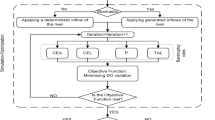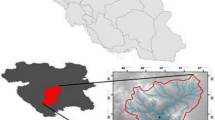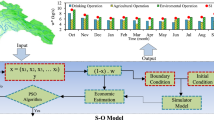Abstract
Pollution of water resources particularly surface water and rivers may affect human health and the environment seriously. So it is essential to find an efficient solution to control the pollution at rivers in order to reduce damages for consumers and protect the environment. At this research, a mathematical model is proposed to manage pollutant entrance to the river from several resources. The objective is to minimize the rate of pollution damage for consumers by using an analytical solution method and the particle swarm optimization algorithm as river quality management. Two different scenarios for consumption are considered in Gheshlagh River which is selected as a case study. A total of 192 decision variables corresponding to the mass of entering contamination at different hours of the day and 8 decision variables corresponding to the location of entering are considered. In the first scenario, at some hours of the day downstream consumption is zero, and in the second scenario, for all hours of the day, water is consumed at the downstream of Gheshlagh River. The achieved results indicate that the value of objective function for the first scenario, after optimization, decreased from 3513 to 48 kg in its optimal condition. In river quality management planning of two scenarios, the concentration of pollution do not exceed from allowable limit. According to the results, a timetable and spatial planning for pollutant entrance to the river can decrease the rate of pollution damage for consumers.





Similar content being viewed by others
Abbreviations
- ABC:
-
Artificial bee colony
- AMOSA:
-
A multi-objective simulated annealing
- BOD:
-
Biochemical oxygen demand
- C 1 :
-
Cognitive coefficient
- C 2 :
-
Social component coefficients
- DO:
-
Dissolved oxygen
- DoE:
-
Department of environment
- DSS:
-
Decision support system
- GA:
-
Genetic algorithm
- HS:
-
Harmony search
- PSO:
-
Particle swarm optimization
- MPSO:
-
Modified particle swarm optimization
- NLP:
-
Nonlinear programming
- SAR:
-
Search and rescue algorithm
- SDGA:
-
Sequential dynamic genetic algorithm
References
Afshar A, Masoumi F (2016) Waste load reallocation in river–reservoir systems: simulation-optimization approach. Environ Earth Sci. https://doi.org/10.1007/s12665-015-4812-x
Alizadeh MJ, Shabani A, Kavianpour MR (2017) Predicting longitudinal dispersion coefficient using ANN with metaheuristic training algorithms. Int J Environ Sci Technol 14(11):2399–2410. https://doi.org/10.1007/s13762-017-1307-1
Arnold JG, Williams JR, Griggs RH, Sammons NB (1990) A basin scale simulation model for soil and water resources management. A&M Press, Texas, pp 341–356
Asheghmoala M, Fazel AM, Homami M (2014) The effect of river assimilative capacity in determination of allowable water quality parameters in sewages. Environ Sci Eng 1(4):37–49
Ashtiani F, Niksokhan MH, Ardestani M (2015) Multiobjective waste load allocation in river system by MOPSO algorithm. Int J Environ Res 9(1):69–76
Atibu EK, Lacroix P, Sivalingam P, Ray N, Giuliani G, Mulaji CK, Otamonga JP, Mpiana PT, Slaveykova VI, Poté J (2018) High contamination in the areas surrounding abandoned mines and mining activities: an impact assessment of the Dilala, Luilu and Mpingiri Rivers, Democratic Republic of the Congo. Chemosphere 191:1008–1020. https://doi.org/10.1016/j.chemosphere.2017.10.052
Batu V (2005) Applied flow and solute transport modeling in aquifers, fundamental principles and analytical and numerical methods. CRC Press, Boca Raton
Chen CW, Wells J (1975) Boise river water quality-ecological model for urban planning study. Idaho Water Resource Board and Idaho Dept, Walla
Chen JS, Liu CW, Liang CP, Lai KH (2012) Generalized analytical solutions to sequentially coupled multi-species advective-dispersive transport equations in a finite domain subject to an arbitrary time-dependent source boundary condition. J Hydrol 456:101–109. https://doi.org/10.1016/j.jhydrol.2012.06.017
Craig RC, Read WW (2010) The future of analytical solution methods for groundwater flow and transport simulation. In: XVIII international conference on water resources
Dehghani Darmian M, Hashemimonfared SA, Azizyan G, Snyder SA, Giesy JP (2018) Assessment of tools for protection of quality of water: uncontrollable discharges of pollutants. Ecotoxicol Environ Saf 161:190–197. https://doi.org/10.1016/j.ecoenv.2018.05.087
Delavar M, Morid S, Moghaddasi M (2014) Developing an optimization-simulation risk based water allocation model using conditional value at risk (Cvar), case study: zayandehrood irrigation networks. Iran Water Resour Res 10(1):1–14
Eberhart RC, Kennedy J (1995) A new optimizer using particle swarm theory. In: Proceedings of the sixth international symposium on micro machine and human science. https://doi.org/10.1109/mhs.1995.494215
Eberhart R, Shi Y, Kennedy J (2001) Swarm intelligence, 1st edn. Morgan Kaufmann, San Francisco
Farhadian M, Haddad OB, Seifollahi-Aghmiuni S, Loáiciga HA (2015) Assimilative capacity and flow dilution for water quality protection in rivers. J Hazard Toxic Radioact Waste 19(2):04014027. https://doi.org/10.1061/(ASCE)HZ.2153-5515.0000234
Fischer HB (1975) Discussion of simple method for predicting dispersion in streams. By McQuiver, R. S. and Keefer, T. N. J Environ Eng 101:453–455
Geem ZW, Kim JH, Loganathan GV (2001) A new heuristic optimization algorithm: harmony search. Simulation 76(2):60–68. https://doi.org/10.1177/003754970107600201
Guerrero JSP, Pimentel LCG, Skaggs TH, Van Genuchten MTh (2009) Analytical solution of the advection–diffusion transport equation using a change of variable and integral transform technique. Int J Heat Mass Transf 52:3297–3304. https://doi.org/10.1016/j.ijheatmasstransfer.2009.02.002
Hamidi Machekposhti K, Sedghi H, Telvari A, Babazadeh H (2018) Modeling climate variables of rivers basin using time series analysis (case study: Karkheh River Basin at Iran). Civ Eng J 4(1):78–92. https://doi.org/10.28991/cej-030970
Hashemi Monfared SA, Dehghani Darmian M, Snyder SA, Azizyan G, Pirzadeh B, Azhdary Moghaddam M (2017) Water quality planning in rivers: assimilative capacity and dilution flow. Bull Environ Contam Toxicol 99(5):531–541. https://doi.org/10.1007/s00128-017-2182-7
Hernandez EA, Uddameri V (2013) An assessment of optimal waste load allocation and assimilation characteristics in the Arroyo Colorado River watershed, TX along the US–Mexico border. Clean Technol Environ Policy 15(4):617–631. https://doi.org/10.1007/s10098-012-0546-6
Holland JH (1992) Genetic algorithms. Sci Am 267(1):66–73
Jawaduddin M, Memon SA, Bheel N, Ali F, Ahmed N, Abro AW (2019) Synthetic grey water treatment through FeCl3-activated carbon obtained from cotton stalks and river sand. Civ Eng J 5(2):340–348. https://doi.org/10.28991/cej-2019-03091249
Karaboga D, Basturk B (2007) A powerful and efficient algorithm for numerical function optimization: artificial bee colony (abc) algorithm. J Glob Optim 39(3):459–471. https://doi.org/10.1007/s10898-007-9149-x
Karamouz M, Kerachian R, Mahmoodian M (2003) Seasonal waste-load allocation model for river water quality management: application of sequential dynamic genetic algorithms. World Water Environ Resour Congr. https://doi.org/10.1061/40685(2003)75
Khazaee M, Hamidian AH, Alizadeh Shabani A, Ashrafi S, Mirjalili SAA, Esmaeilzadeh E (2015) Accumulation of heavy metals and As in liver, hair, femur, and lung of Persian jird (Meriones persicus) in Darreh Zereshk copper mine, Iran. Environ Sci Pollut Res. https://doi.org/10.1007/s11356-015-5455-x
Khorashadizadeh M, Hashemimonfared SA, Akbarpour A, Pourrezabilondi M (2016) Uncertainty assessment of pollution transport model using GLUE method. Iran J Irrig Drain 3(10):284–293
Khorashadizadeh M, Azizyan G, Hashemimanfared SA, Akbarpour A (2018) Sensitivity analysis of two-dimensional pollution transport model parameters in shallow water using RSA method. Iran J Soil Water Res 49(5):1119–1129. https://doi.org/10.22059/ijswr.2018.244628.667779
Khoshkam H, Saadatpour M, Heidarzadeh N (2017) Single/multi waste load allocation in Gheshlagh River; simulation-optimization approach. Iran Water Resour Res 13(2):99–114
Kim KC, Park GH, Jung SH, Lee JL, Suh KS (2011) Analysis on the characteristics of a pollutant dispersion in river environment. Ann Nucl Energy 38:232–237. https://doi.org/10.1016/j.anucene.2010.11.003
Kumar A, Jaiswal D, Kumar N (2009) Analytical solutions of one-dimensional advection–dispersion equation with variable coefficients in a finite domain. J Earth Syst Sci 118(5):539–549. https://doi.org/10.1007/s12040-009-0049-y
Liu D, Guo S, Shao Q, Jiang Y, Chen X (2013) Optimal allocation of water quantity and waste load in the Northwest Pearl River Delta, China. Stoch Environ Res Risk Assess. https://doi.org/10.1007/s00477-013-0829-4
Mohtashami A, Akbarpour A, Mollazadeh M (2017) Development of two-dimensional groundwater flow simulation model using meshless method based on MLS approximation function in unconfined aquifer in transient state. J Hydroinform 19(5):640–652. https://doi.org/10.2166/hydro.2017.024
Nigel WT, Quinn PE (2005) Advancing the concept of real-time water quality management in the San Joaquin Basin. Hydro ecological engineering advanced decision support berkeley national laboratory, Berkeley, CA. CWEMF annual meeting Asilomar, California
Paik J, Park SD (2011) Numerical simulation of flood and debris flows through drainage culvert. Ital J Eng Geol Environ 15:487–493. https://doi.org/10.4408/IJEGE.2011-03.B-054
Saadatpour M, Afshar A, Khoshkam H (2019) Multi-objective multi-pollutant waste load allocation model for rivers using coupled archived simulated annealing algorithm with QUAL2Kw. J Hydroinform. https://doi.org/10.2166/hydro.2019.056
Sahab MG, Toropov VV, Gandomi AH (2013) A review on traditional and modern structural optimization: problems and techniques. In: Metaheuristic applications in structures and infrastructures, pp 25–47. https://doi.org/10.1016/B978-0-12-398364-0.00002-4
Saremi A, Sedghi H, Manshouri M, Kave F (2010) Development of multi-objective optimal waste model for Haraz river. World Appl Sci J 11(8):924–929
Shabani A, Asgarian B, Gharebaghi SA, Salido MA, Giret A (2019) A new optimization algorithm based on search and rescue operations. Math Probl Eng. https://doi.org/10.1155/2019/2482543
Shojaeefard MH, Tahani M, Ehghaghi MB, Fallahian MA, Beglari M (2012) Numerical study of the effects of some geometric characteristics of a centrifugal pump impeller that pumps a viscous fluid. Comput Fluids 60:61–70. https://doi.org/10.1016/j.compfluid.2012.02.028
Shourian M, Mousavi SJ, Menhaj MB, Jabbari E (2008) Neural-network-based simulation-optimization model for water allocation planning at basin scale. J Hydroinform 10(4):331–343. https://doi.org/10.2166/hydro.2008.057
Singh P, Yadav SK, Kumar N (2012) One-dimensional pollutant’s advective diffusive transport from a varying pulse-type point source through a medium of linear heterogeneity. J Hydrol Eng 17(9):1047–1052. https://doi.org/10.1061/(ASCE)HE.1943-5584.0000553
Strehmel A, Schmalz B, Fohrer N (2016) Evaluation of land use, land management and soil conservation strategies to reduce non-point source pollution loads in the three gorges region, China. Environ Manag 58:906–921. https://doi.org/10.1007/s00267-016-0758-3
Toro FE (2001) Shock-capturing methods for free-surface shallow flows. Wiley, Chichester
Van Genuchten MTh, Alves WJ (1982) Analytical solutions of the one-dimensional convective–dispersive solute transport equation. U.S. Department of Agriculture Technical Bulletin
Vazquez ME (1999) Improved treatment of source terms in upwind schemes for the shallow water equations in channels with irregular geometry. J Comput Phys 148:497–526. https://doi.org/10.1006/jcph.1998.6127
Wen CG, Lee CS (1998) A neural network approach to multiobjective optimization, for water quality management in a river basin. Water Resour Res 34(3):427–436. https://doi.org/10.1029/97WR02943
World Meteorological Organization Technical Report (2013) Planning of water-quality monitoring systems
Wu M, Tang X, Li Q, Yang W, Jin F, Tang M, Scholz M (2013) Review of ecological engineering solutions for rural non-point source water pollution control in Hubei province, China. J Water Air Soil Pollut 224(5):1–18. https://doi.org/10.1007/s11270-013-1561-x
Yadav RR, Jaiswal DK, Yadav HK (2010) Analytical solution of one dimensional temporally dependent advection–dispersion equation in homogeneous porous media. Int J Eng Sci Technol 2:141–148. https://doi.org/10.4314/ijest.v2i5.60133
Zewdie M, Murty Bhallamudi S (2012) Multi-objective management model for waste-load allocation in a tidal river using archive multi-objective simulated annealing algorithm. Civ Eng Environ Syst 29(4):222–230. https://doi.org/10.1080/10286608.2012.710607
Zheng NS (1996) Mathematical modeling of groundwater pollution. Springer, Berlin. https://doi.org/10.1007/978-1-4757-2558-2
Acknowledgements
No financial support was provided for this study.
Author information
Authors and Affiliations
Corresponding author
Ethics declarations
Conflict of interest
The authors declare that they have no conflict of interest.
Additional information
Editorial responsibility: S. R. Sabbagh-Yazdi.
Rights and permissions
About this article
Cite this article
Khorashadizadeh, M., Azizyan, G., Hashemi Monfared, S.A. et al. A timetable and spatial planning for pollutant entrance to the river. Int. J. Environ. Sci. Technol. 17, 4171–4188 (2020). https://doi.org/10.1007/s13762-020-02722-z
Received:
Revised:
Accepted:
Published:
Issue Date:
DOI: https://doi.org/10.1007/s13762-020-02722-z




